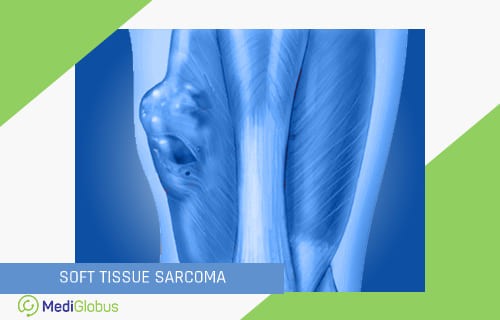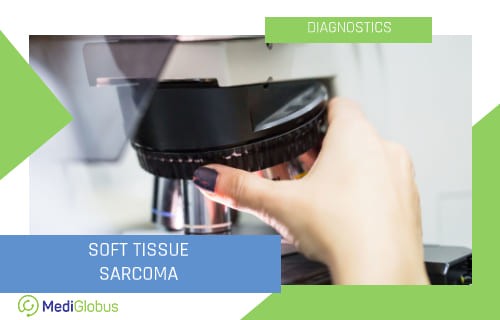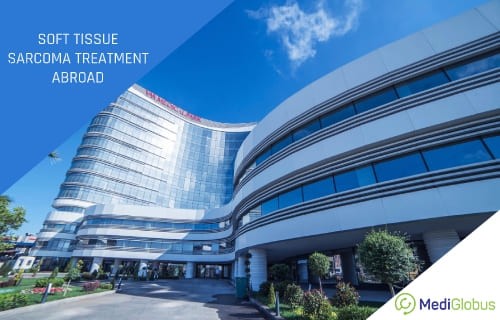Soft tissue sarcoma is a rare type of cancer that accounts for about 1% of adult cancer cases and 15% in children. Soft tissue cancer is detected in 13,000 people every year. Survival depends on the tissue from which the tumour grows and in which part of the body it is located. You can learn about the treatment of soft tissue sarcoma in this article.
What is soft tissue sarcoma?
Soft tissue sarcoma is a group of cancers that affect muscles, fatty tissue, blood vessels, nerves and joints. There are about 50 subtypes of soft tissue cancer, the most common among them:
Liposarcoma
Liposarcoma grows from fat cells. It is usually found in the fat layer of the limbs and abdomen. It accounts for about 18% of all soft tissue cancers. Typically it occurs in men and women between 40 and 60 years of age. The five-year survival rate is between 56% and 100%, depending on the type of liposarcoma and the stage at which it was detected.
Leiomyosarcoma
Leiomyosarcoma affects muscle tissue. Most often the tumours (up to 10 cm) grow in the abdominal area or on internal organs. The main symptoms are pain, weight loss, bloody vomiting. Leiomyosarcomas account for about 5-10% of all soft tissue cancers. Among men, leiomyosarcoma is more common. The survival rate of leiomyosarcoma is higher if detected at an early stage.
Synovial sarcoma
Synovial sarcoma most often affects the soft tissues near the joints, but it may also be in the lungs or abdominal organs. It is more common in men in adolescence and adulthood. Synovial sarcoma is usually not painful, so it may go unnoticed for a long time. The five-year survival rate is 36-76%.
Angiosarcoma
Angiosarcoma affects blood vessels and lymphatic tracts. If it is located in internal organs, the main symptom is a pain. Angiosarcomas located close to the skin look like misshapen purple or reddish bruises. This type of soft tissue sarcoma most often affects people over the age of 70.
Most often, soft tissue sarcoma grows in arms or legs, but it can occur in any part of the body. Thigh sarcoma is the most common form of soft tissue cancer in the lower limbs.
The main symptoms are lumps and swelling. Sometimes it can be painful, sometimes it can’t.
The exact cause of soft tissue sarcoma is unknown. Inheritable factors play a role. In addition, radiation and certain chemicals (arsenic, vinyl chloride, dioxin) are risk factors.

Diagnosis of soft tissue sarcoma

The diagnosis is confirmed with a biopsy. During this procedure, the doctor uses a special needle to take a sample of the tumour, which is then analyzed in the laboratory. The procedure is performed under local anaesthesia. If the test confirms the presence of malignant cells, the oncologist will prescribe a suitable treatment. After the biopsy, the doctor may prescribe additional tests, for example:
Immunohistochemistry – a laboratory test that uses antibodies to determine the subtype of cancer.
Ultrasound – external examination of a tumour. The procedure is harmless and painless.
MRI – examination with the help of magnetic resonance tomography. This stage is especially important for the surgery, as the doctors use MRI to determine the exact location of the tumour.
Soft tissue sarcoma is often mistaken for other types of cancer, such as bone cancer.
In addition, a doctor can take tissue for genetic analysis, which will help determine which medicine will be more effective.
Soft tissue sarcoma prognosis
The prognosis of soft tissue sarcoma is higher if the disease was detected at an early stage. In general, this group of neoplasms is considered difficult to treat. Many new cancer treatment methods are aimed at improving the effectiveness of soft tissue cancer therapy.
Many factors influence the disease prognosis:
Type and stage of sarcoma;
Tumour size and location;
Speed of malignant cell growth;
Possibility to completely surgically remove the tumour;
The age and health of the patient;
Metastases and relapses.
On average, the five-year survival rate for soft tissue sarcoma is 65%. If treatment is started in the first stages, before cancer cells begin to spread through the body, this percentage grows to 81%.
Treatment of soft tissue sarcoma
The treatment depends on the type and stage of sarcoma, its location, as well as the age of the patient and their general condition.
Surgery
Surgery is the most common form of soft tissue sarcoma treatment. In some cases, surgical intervention is enough.
Sometimes the tumour is reduced before surgery with chemotherapy or radiotherapy. This treatment is called neoadjuvant therapy. If the therapy is carried out after the operation, it is considered adjuvant. Its purpose is to destroy residual malignant cells. During the operation, the surgeon can use these procedures:
Mohs microsurgery. The tissue is removed in thin layers, and the healthy cells remain mostly intact. This technique is most often used on skin neoplasms.
Wide local excision. The doctor removes the tumour together with the neighbouring tissues. It is used to treat the head, abdomen, neck and torso tumours.
Lymphodisection. Neighbouring lymph nodes are removed along with the tumour.
Radiotherapy
During radiotherapy, the patient is treated with X-rays destructive to cancerous cells. Modern treatment methods, such as proton therapy or FLASH therapy, allow the radiation to concentrate on malignancies, minimally affecting healthy tissue.
Radiotherapy can be performed both externally and internally. External radiotherapy uses devices that produce radiation and direct it to the tumour. In internal radiotherapy, the radiation source is placed in the patient’s body next to or inside the tumour.
Chemotherapy
Chemotherapy consists of taking a group of drugs that can destroy cancer cells. They are taken intravenously, as an injection or pills. The duration of the course and the choice of medication depends on the type and stage of cancer.
After the course of basic treatment, the patient should have regular check-ups. This is done in order to prevent relapse. The more years have passed since the end of therapy, the fewer checkups are needed.
Patients may also need physiotherapy or occupational therapy to recover from surgery.
Where is soft tissue sarcoma treated abroad?
In Europe, quality soft tissue cancer treatment is provided in Germany, Spain and the Czech Republic. Medical centres of these countries co-operate with research institutes and possess modern technologies of oncological diseases treatment. In addition, they often have trials of new drugs and treatment methods, in which patients can participate.
Among German institutions, MediGlobus clients most often choose the Rechts der Isar Hospital and the Vienna Private Clinic. In Spain, Quironsalud is one of the largest networks in Europe. In addition, there is a good oncology department at the Teknon Clinic.
Doctors from Israel and Turkey, among other countries, have made great progress. Israel is especially known for pediatric oncology. Oncology in Turkey is on the top level, and it is cheaper than in other countries. Turkish hospitals possess modern equipment, and professional doctors with world reputation follow international treatment protocols.

The most popular Israeli clinics for cancer treatment are Suraski (Ichilov) and Assuta. Among Turkish hospitals worth mentioning are Medical Park, Liv, and Koç.
If you are interested in the treatment of soft tissue sarcoma, leave a request on our website, and you will be contacted by our coordinators. They will answer all your questions and help you choose the country and the hospital. In addition, you will receive assistance with travel arrangements and support throughout the treatment.





